The story of Crocker motorcycles has been obscured by tall tales and myths since the very day they were introduced, first as Speedway racers, then big V-twins, and finally a scooter, all built before official US involvement in WW2 put a halt to civilian motorcycle production. Wading through the murk around this famous American name, one bumps against vested interests and fast-held opinions, but enough facts emerge to which we can anchor our tale. What is definitely known is they have skyrocketed in value in the past decade, filling many spots on our Top 100 Most Expensive Motorcycles list.
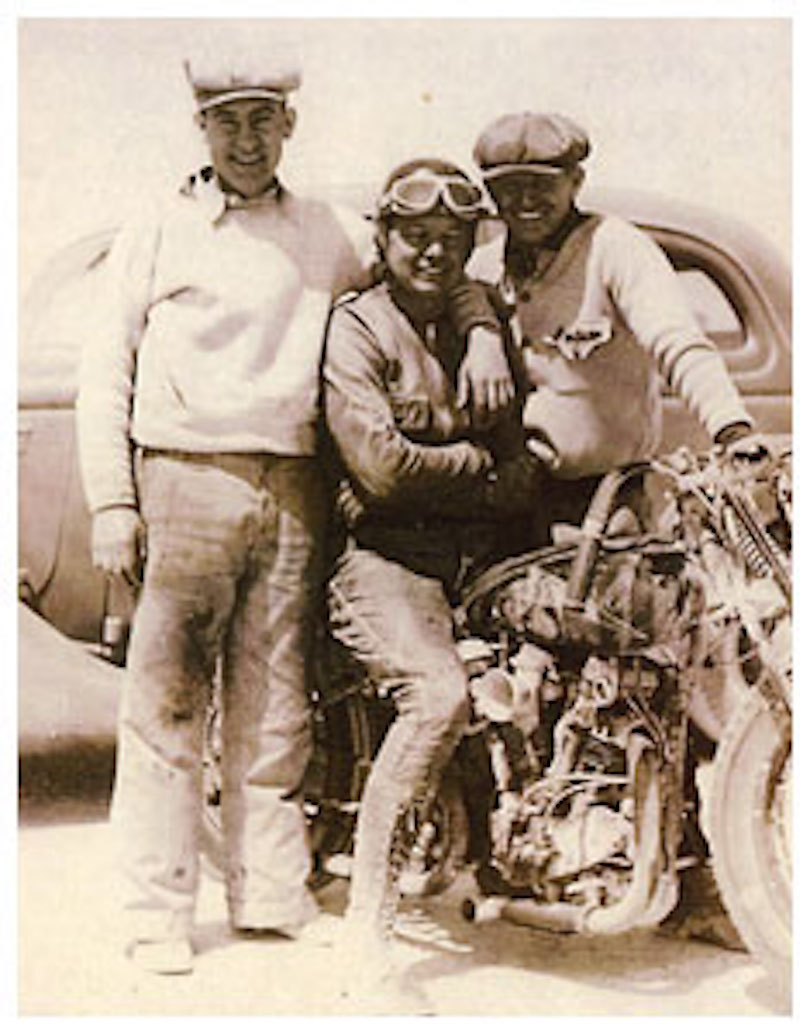
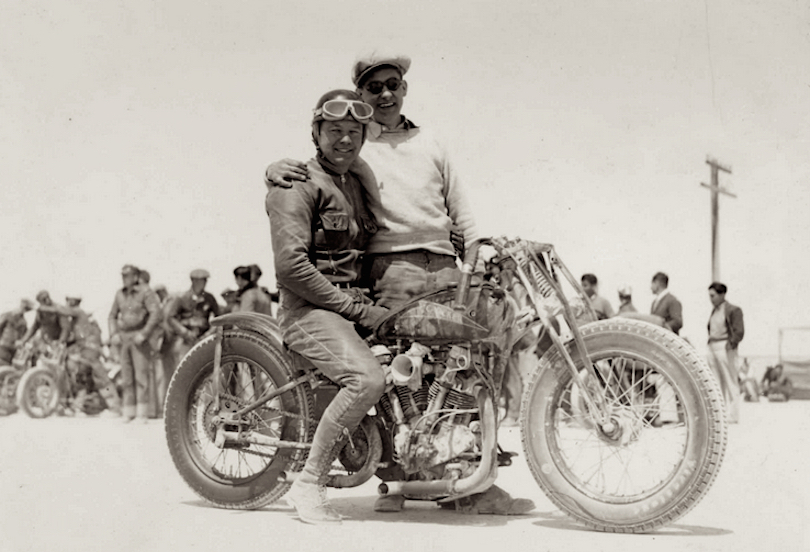
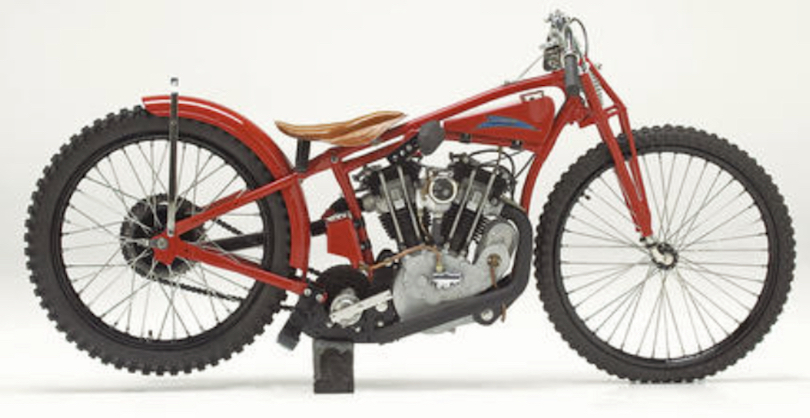
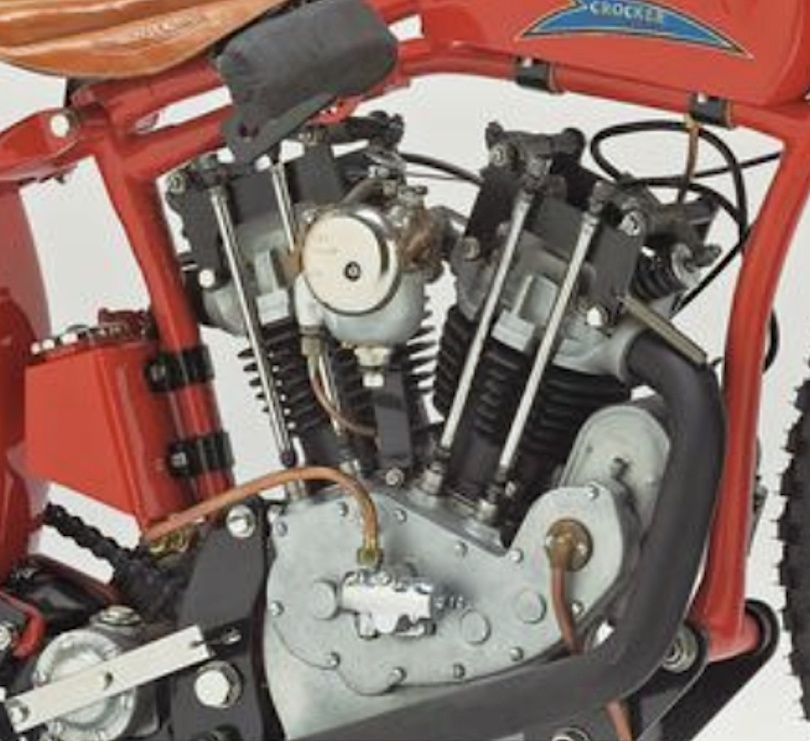
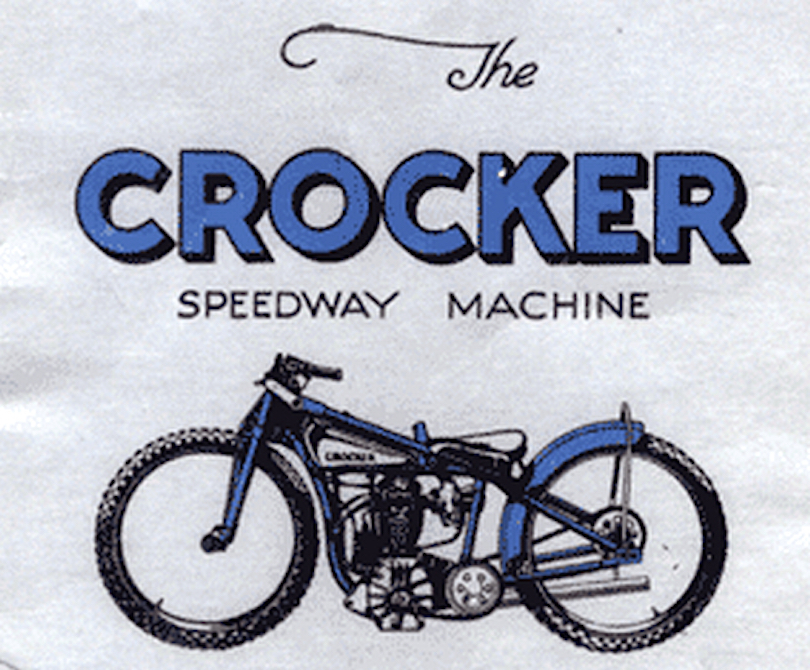
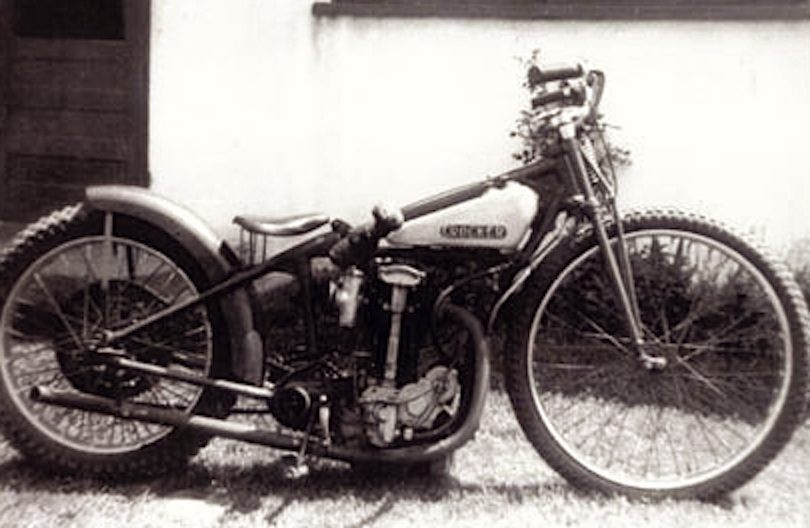
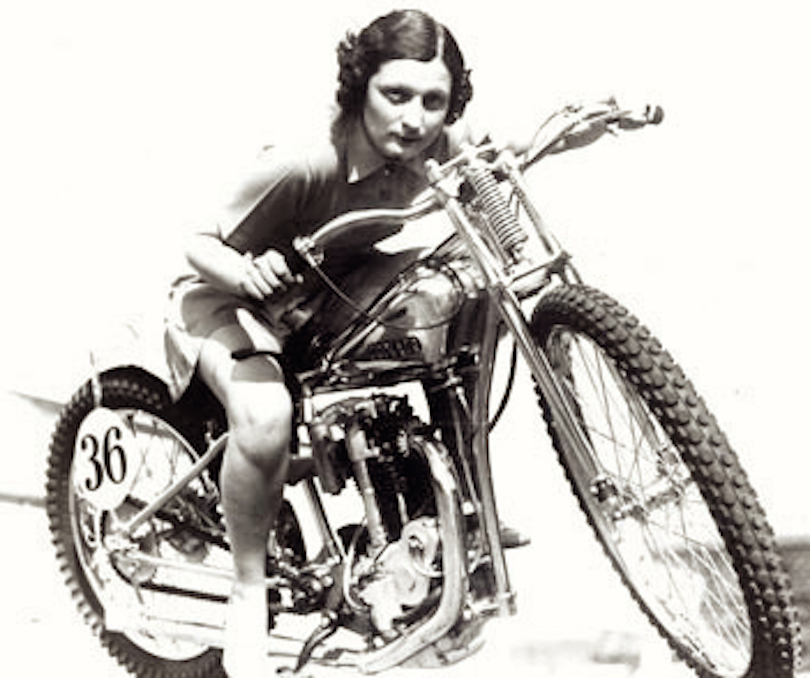
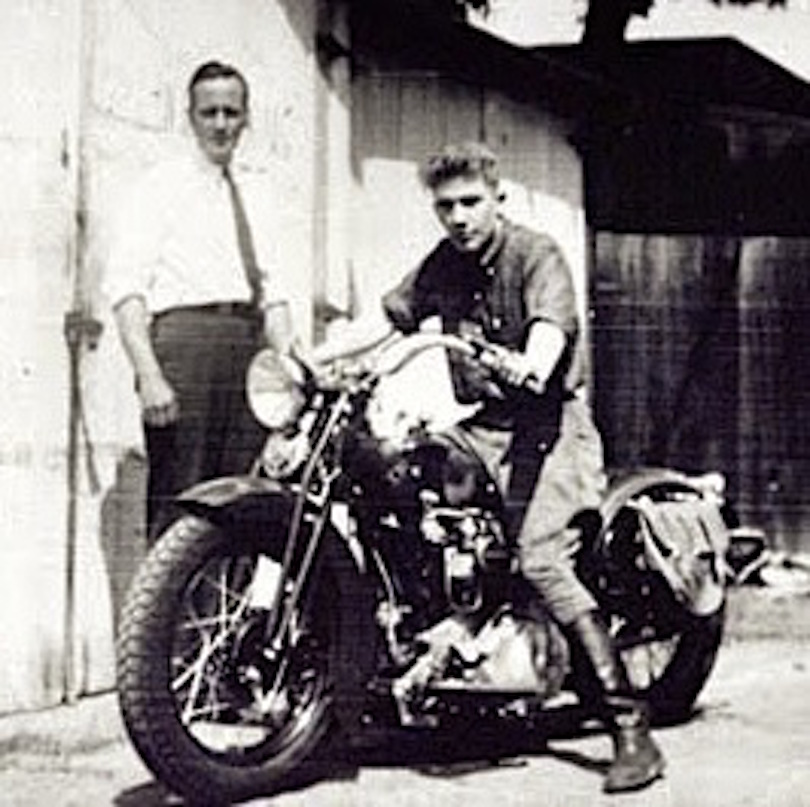
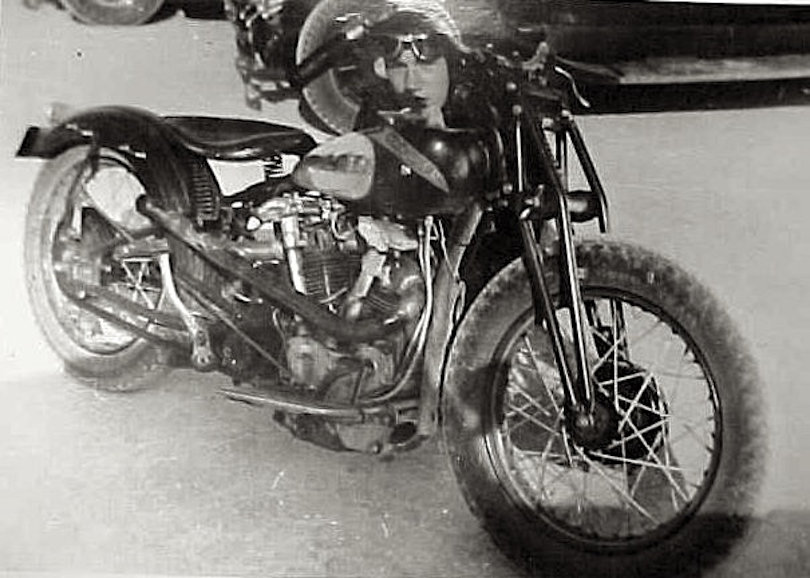
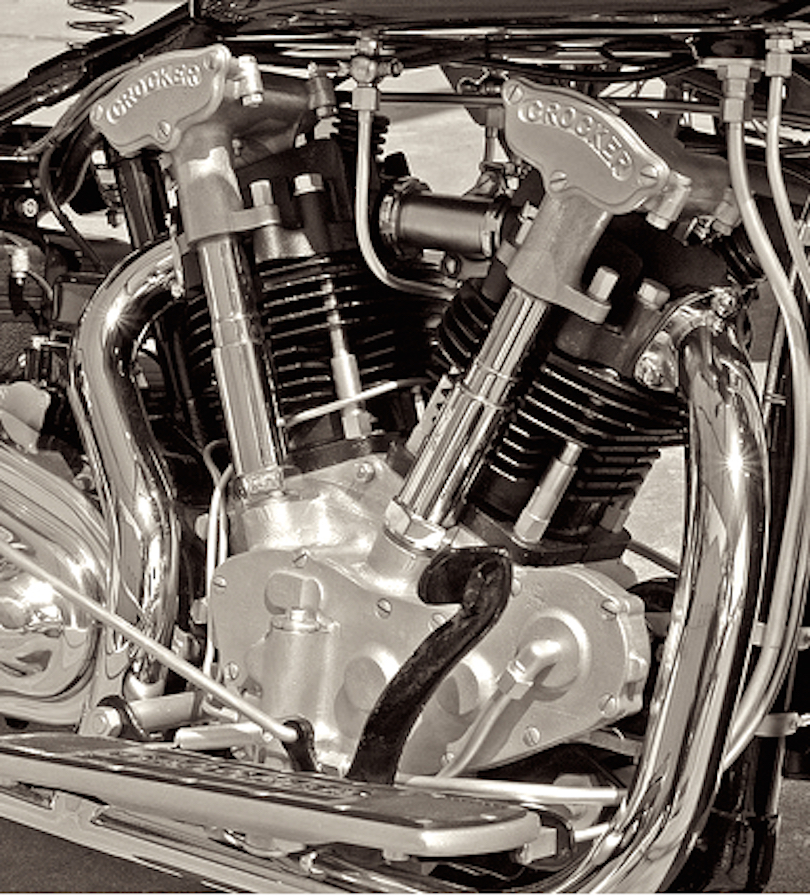
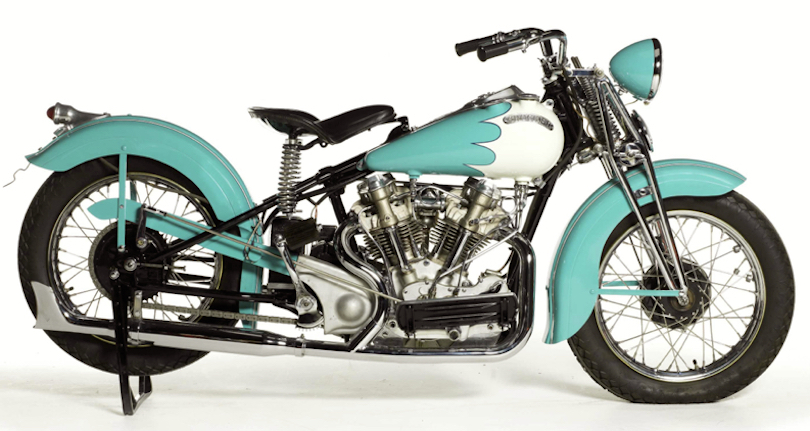
The Crocker has rightly become a coveted and very expensive machine, deserving of its place on the Olympus of Motorcycles, with the Brough SS100, Vincent Series A Rapide, and Zenith Super 8; the world’s first 100+mph production motorcycles. All were big, impressive V-twin Superbikes built in small numbers for a very discerning clientele…and all are very, very expensive today.
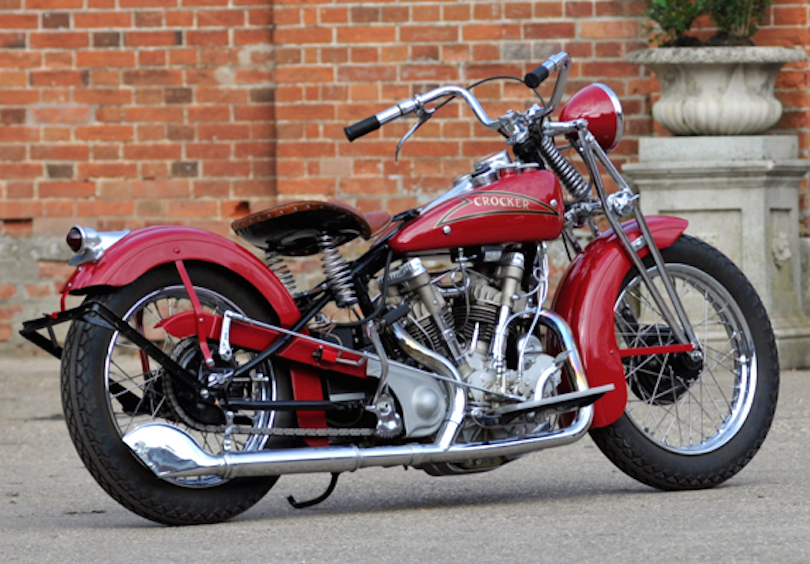
Related Posts
July 25, 2017
The Vintagent Trailers: Morbidelli – a Story of Men and Fast Motorcycles
Discover the story of the Morbidelli…

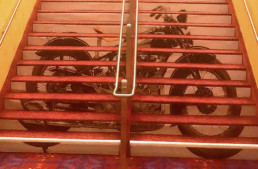
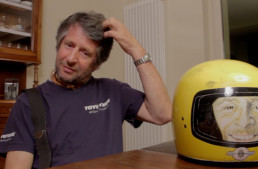
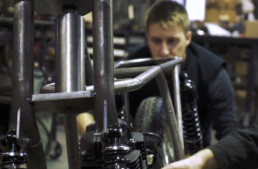
Very interesting article. All I’ve ever read has been about the roadbikes, had no idea of all the dirt racing history involving Crocker.
The Cinders to Shale Speedway museum in Loanhead Scotland has a Crocker amongst it’s exhibits. This is without doubt the largest collection in the world.
Great article good sir … especially in light if the myths being perpetuated about who did what at Crocker by Bigsby’s bio in the automotive/motorcycle/music press of late . Methinks a full length – quality book is well overdue about the Legendary Crocker motorcycles and its creator / team
BTW I completely agree with the comment about Bigsby being one to toot his own horn ….. not to mention snagging more than his fair share of credit over the years .
Well done Paul. Paul Bigsby WAS a very talented and envolved motorcyclist. He was a founding member of the LA 45 m/c club. A very good tool and die man, pattern maker, and machist no matter what is said. Chuck Vernon and Ernie Skelton knew Al Crocker and Paul very well. I’m glad to have spent many hours with them in the early sixties and seventies and get alot of the stories first hand. It’s amazing how many of these limited production fine machines have survived to this day.
More than amazing ‘coz most of the machines that “survived” are actually composites/ fakes… Skelton and Vernon key parts of a huge scam then & after that has involved rip-off restorers in cahoots for decades. Certainly anything over #100 is a repop. Elites of course absolutely terrified that this truth about their phony investments will ever become known, maybe while hodling bitcoin too! 🙂 Plenty of evidence and documentation out there on how the Crocker scam has played out, beginning with the phony Sucher story which has worked out well for all the scammers who have come after..
Great read man, thanks a ton.
Cheers and beers
Crockers take the top three spots at the Bonhams auction ($302K – $291K ) Over and above the cars sold as well as a Brough .
Richard Worsham said…
Wonderful story. I’ve always been a bit confused about Crocker’s relationship with Indian and Harley. Great stuff.
Thanks,
Richard
Great article i did learn about the Thor era which i was unaware. Thanks for the info and yes a book would be awesome. LOL im trying to track it down and see if he was any relation. wish me luck.
The red, ’33 Crocker twin conversion listed at 500cc is actually 750cc. It was built by Gwen Banquer for Mike Corbin in 1999 and was introduced at the Daytona Bike show that year. It has a 1933 Rudge frame (not Crocker), but this Rudge frame type was likely to have been utilized by Crocker before he began making his own. The 101 Scout engine does not have a factory stamped VIN#, so it was probably a race motor to begin with. I believe that this engine has the automatic oil pump which was on the ’31 101 model.
By the way, I am the current owned of this machine.
HERE AGAIN WE HAVE CROCKER LACK OF PROPER KNOWLEDGE. ERNIE SKELTON AND CHUCK VERNON NEVER MET AL CROCKER, OR P.A. BIGSBY. ERNIE WAS BEST OF FRIENDS WITH THE LOOPER BROTHERS ESPECIALLY ELMO LOOPER. LETS GET CROCKER FACTS STRAIGHT. CHUCK VERNON IS ALIVE AND WELL AND HE WILL TELL YOU HE NEVER MET AL CROCKER OR P.A. BIGSBY.
My old pal chuck vernon died a few years back. Wish he was still around.
Does anyone know if there exists any video archival footage of a crocker being raced?
good for you Randy for spotting those inaccuracies. It would also be nice to see correct attribution of Homer Wood taking delivery of Crocker serial #4 from Al Crocker. This was the first twin sold to the public. Homer rode this across America in 1936 to take up his Masters studies in Engineering at Harvard. ( His thesis centered around a Crocker single engine. ) The valve seats of #4 came loose in Idaho but Al sent Homer another set of heads with the seats cut in the heads rather than inserted.
This is all first hand info as I corresponded with Homer and was the first recipient of 2 of the above photos from him. Check out the article I wrote for “The Classic motorcycle Magazine”
Sorry, Crocker guys $$-ed old hippies* obsessed with attempting to recapture some iconic moment of their wayward drug-addled wasted youth, by liquidating those $$ on these bikes. Eventually these guys (all guys btw) stumbled into big bucks… either through some criminal enterprise known as Wall Street, or by blind luck. That of course is their sell-out right, and freedom to do. But it’s a legacy totally rejected and resented by the young & younger people today.
*Hippie – Wikipedia
[Search domain en.wikipedia.org] https://en.wikipedia.org › wiki › Hippie
Many hippies would adapt and become members of the growing countercultural New Age movement of the 1970s. While many hippies made a long-term commitment to the lifestyle, some people argue that hippies sold out during the 1980s and became part of the materialist, self-centered consumer yuppie culture.
Skelton was not best friends with Elmo Looper. Randy W , has spoken with Elmo’s son and so have I, and Randy was told the same story told to me. Randy might not like what he was told but Im writing a series of articles on the subject.
Skelton borrowed the Bigsby drawings and he did not give them back. Harry wrote in IRON REDSKIN, that Skelton had “possession” of the drawings, which is 9/10th of the law. Murray Looper never saw the drawings again. There is also a PM Panther bike involved. . Elmo never bought any inventory of parts, the drawings contain the inventory.
The sole purpose of the drawings is to make parts, and parts make bikes, and that is why the Crocker Register exists.
The Crocker family are now up to speed on what has happened since 1970. Elmo also owned 36-61-4 and so did Murray and Billy Looper, that bike got parted out by Skelton but then Elmo’s bike 38-61-38 also got stripped of internals = 86″ knucklehead Crocker , built 7 years before CB Clausen and Hood built 80″ Knucklehead in 1948. Elmo built #38, not JD Cameron
Elmo Looper had nothing to do with Harry Sucher bike 38-61-31, Harry wrote what he wanted and no one questioned it.
Sucher, Chuck and Skelton made up most of the Crocker history
I lived with mr. Ernie Skelton and his wife Mary for about 24 years. I knew him well. I do so dislike all the bull***information now going on..I have owned 6 crockers and was personal friends with the first owner of Crocker number 4. Homer Wood’s was a good friend with whom I have personally met several times…Tell enough lies and they become fact…Good luck…Randy Wiggins…
Randy Wiggins, you dislike BS, then you won’t like this = Skelton died 1995. “24 years” would make it 1971. Skelton lived in Westminster with his wife, NOT Mary _ _ _ _ _. ‘Walneck’s” magazine is online, FREE. In 1987 you placed want ads for Crocker parts with phone and address, which was NOT Skelton’s address. Phone books are online too, FREE. If you knew Skelton so well, why didn’t you get parts direct from him (when you lived with him). Homer Wood supplied 3 photos of a 1937 Crocker that his father bought him. 2 of those photos are on this page. The front brake drum is clearly on the LEFT fork leg. The early 1936 Crockers had the front brake drum on the RIGHT fork leg, photos are available online. ‘Motorcyclist’ magazine debuted 2 photos of the first Crocker.
Crocker’s were advertised at 61″, $480 and $5 paint option. Engine size was not an option. Replica’s use HD con rods and 3-5/16″ pistons, which can never calculate to 61″, (+.060 = 65″). There simply is not enough Crocker connecting rods to go around therefore the replicas can only use HD, polishing HD rods does nothing to hide the con rod length.
pay attention to how many bikes have stroker plates and the sneaky ones use new longer cylinders. There is no trace of the 1935 prototype bike. According to Crocker register , Elmo Looper and Arte Smythe built 40-61-117 and Smythe owned 42-61-301.
The Looper family have never heard of Smythe and there is no trace of such person in voter, census, draft, directory yet Jack Gormley claimed in a magazine he got the address and phoned Smythe thru the Crocker Register to buy 301. another problem….. there were no mechanics working for Crocker in 1942. production of the Scooters started after Parriott took the bikes to the last big day out in 1940 and scooter production ended in 1941. Popular Science, Popular mechanics and Motorcyclist mags.
Elmo Looper never had a bike with a lever mechanism seat, no one did. Chuck Vernon claimed he had the Prototype and Elmo’s bike with 1947 pink slip, an actual signature, or one just like it ?
Elmo Loopers son has never heard of Chuck Vernon or Harry Sucher
Chuck Vernon and Ernie Skelton had no first hand stories or experience. Bigsby was a member of Trailblazers and resigned march 1963, he was not contacted for any comment on Crocker.
No attempt was made in the 1970s, 1980s or 1990s to contact Al Crocker Jnr to get the true facts about his father, the business or the bikes, instead Gene Rhynes name has been used to fortify the BS story line.
It says something about Harry Sucher’s selective research for his book and articles.
The story says the Crocker mc co was sold to Borg Warner, when ? the records don’t show that to be true at all, in fact its BS.
Harry Sucher wrote “Milwaukee Marvel” yet he did not mention Crocker using HD con rods. No historian is going to touch that story, it might even attract attention from HD. Its a no-go!
‘The Antique MC’ fall 1971 vol 10, No.3 , Harry wrote about what Skelton did, to restore his bike 38-61-31 = “HARLEY CON RODS”.
A long forgotten article but there it is, go read it.
The 2010 register has 72 + the 4 extras since. but that does not include 37-61-16, 38-61-42 and 40-61-119…. yet to fall out of the casting molds, that totals 79 so far.
As for 36-61-4, this bike went to Elmo who stroked it and then he gave it to Murray Looper in August 1951, it was painted Gold, single spring chrome forks, Indian chain guard and 249 front Guard. This went to Billy Looper as a basket case and then Murray sold it in 1980, (including hand written receipt) and Skelton parted it out (yes he did that).
The bike Randy W got had dual spring forks and god knows what chassis.
And also Homer Wood did NOT stamp his name any where on it , he had no reason to open the engine let alone stamp graffiti.
Elmo did NOT scribe his name inside the cam cover of 37-61-22, it shouldn’t be too hard to work out who did it all the graffiti.
Skelton’s last project was 39-61-107 which supposedly got NOS parts, but where from ? no one can actually present the truth.
The Bigsby drawings keep getting in the way of a good story. no one is going to say how Skelton got those drawings and who from and why and what for.
Sucher forgot the facts, he certainly did not print them
If Elmo Looper had the entire Crocker inventory in his shed, then why did Skelton need to “borrow” the Bigsby drawings ?
would it not be easier to buy parts directly from his best-est friend Elmo ?
The fact that Skelton “borrowed” the drawings is proof that there was never an inventory
Why didn’t Skelton print copies and return the original Drawings to Murray Looper ?
The Bigsby drawings are intellectual property of Al Crocker, possession of the drawings is ownership = no copy right, no royalties
Returning the drawings to Murray would be non productive
Harry Sucher wrote that Skelton had “possession” of the drawings , this is as good as a public notice. with no legal action or response, then legally the drawings belonged to Skelton. That is the statute of limitations at work.
Murray was not an AMCA member, how could he possibly read the club mag or know about ‘Iron Redskin’.
The 1971 club mag and Iron Redskin are almost word for word when mentioning the drawings
Murray asked for the return of the drawings again and again. unaware of the process under way.
He never saw the drawings again.
There is no prestige surrounding Crocker motorcycles and they were never compared to Duesenberg cars and Duesenberg car owners make no comparison to Crocker’s either.
Harry Sucher wrote about the Bigsby drawings twice, 1971 and 1977 clearly stating that Skelton had “Possession” of the drawings. Murray Looper asked for the return, but that never happened, he died 1988 and the drawings have never been mentioned again and all trace of Murray’s name has been erased. The drawings represent a whole lot more than just passing mention in Harry Sucher’s book and article. Harry made no attempt to explain where they came from and how they fell into Skelton’s hands. They are the intellectual property of Al Crocker since the day they were drawn, he paid Paul Bigsby to draw them.
Skelton wrote the Crocker Register list, which just kept getting longer up to 1995 when he died. But the list kept getting longer after he died, which means the Scam was kept alive.
Promoting a vehicle as a genuine antique when it is a replica, is Fraud. Any false papers with Elmo Looper’s name is Forgery, he never sold any bikes. He did not service, restore or supply parts for Crocker motorcycles.
His 3 bikes went to Murray Looper who wrote hand written and signed receipt’s, the only genuine proof of genuine bikes. He had a shed of Crocker’s, quite possibly the majority of survivors rescued from scrap.
Murray was not a member of any vintage club and had no connection to the Register or the people associated.
so why didn’t Harry invest in “Crocker” bikes ? too risky
‘Cycle World’ Jan 1993 , Chuck Vernon said “there were 33 of the small tank Crocker’s actually produced, 17 with the Hemi heads and the rests with parallel valve heads. Then came 15 Big tank versions in 1939 and 1940. There were 5 machines in 1941 before production was interrupted” .
This makes a total of 53 bikes but makes no allowance is made for the ‘Scoot-about’ scooters built in late 1940 until mid 1941 as recorded in Popular Mechanics, Popular Science and ‘The Motorcyclist’. There is no proof of any V twin built in 1941. For 50 years the Crocker brand has been dominated by Chuck , Skelton and Harry Sucher. The Crocker Register is unreliable , written to fit their story line, the facts don’t fit. Few bikes have a history going beyond 1970 because most of them are replicas
Hi Paris. Since you are offended by the poor telling of Crocker’s story, why not respond to T.J. Rafferty in this thread who wants to write the facts about it?
Verry interrresting, especially the comments. One apparent factual error early on puts Paul Bigsby at the Indian factory as Al Crocker’s supervisor. Crocker went from Thor to Indian in 1909 and was there for two years. Bigsby would have been 11 years old. He was a smart kid, but…
Thank you – clearly my source for that piece of info was off base…maybe it was the other way around, that Crocker was Bigsby’s supervisor at Indian…once he came of age?
No, don’t think they met till the ’20s in LA. Also, there’s some some ID confusion in the first two photos. Appears Bigsby is identified as Crocker in the second one. Btw, whose shots are those? Working on a Crocker piece for Thunder Press. Thanks. (todrafferty@gmail.com)
No, don’t think they met till the ’20s in LA. Also, there’s some some ID confusion in the first two photos. Appears Bigsby is identified as Crocker in the second one. Btw, whose shots are those? Working on a Crocker piece for Thunder Press. Thanks. (todrafferty@gmail.com)
No, don’t think they met till the ’20s in LA. Also, there’s some some ID confusion in the first two photos. Appears Bigsby is identified as Crocker in the second one. Btw, whose shots are those? Working on a Crocker piece for Thunder Press. Thanks. (todrafferty@gmail.com)
Harry Suchers book is worthless. Al Crocker (1887-1961) never worked at the Indian factory, he was selling Thor in Illinois and then sold Indians in Illinois, then was sent to S.F in 1911. Bigsby never worked at the factory. Harry Sucher and Chuck Vernon combined have spun a story which has stuck for 50 years, they are dead and gone and their BS goes on and on. The photos of Sam Parriott are both small tank models with inline valve and Hemi head. neither of these bikes are promoting the 1939 Big tank. Try and find evidence of a 1940 Crocker any where. There is a poster with Elmo Looper and his Crocker with the suggested year of “1940” written under it. The question should be how did those photos get from Elmo Loopers residence in 1969 to end up on that poster? The Crocker Register was written by Skelton and Chuck who were “Restoring” them. Try and find evidence of previous owners of 36-61-1X and 42-61-310, both BOGUS and each with $1M price tags. Neither Skelton or Chuck have any history with Crocker’s. What promotion exists of the Crocker ? The Motorcyclist mag 1936 debut, the 1938 Dual spring small tank, the 1939 Dual spring Big tank and the 1940 Parriott final horrah, followed by The Motorcyclist Oct 1940 ‘Scootabout’ release. Bigsby left in 1941 and Gene Rhyne not long after. Crockers were sold by Advance order, Homer Wood didnt say his bike was the first bike sold, there were 12 bikes ordered for 1936 . Jack Liily bought his bike in 1942 second hand and he had the photos to prove it, but his story is Bogus. and then there’s JD Cameron’s story…….
Floyd Clymers book ‘A Treasury of Motorcycles of the World’ 1965 predates the Crocker Register and says the Twin was produced for 4 years, that’s 1936 to 1939. that coincides with the Indian release of the sprung frame. Indian was Crocker’s biggest customer. The Crocker steering damper alone was $5.50. 88 of those = $484, that’s the price of a Crocker. The Scoot-about gets in the way of the narrative. Al Crocker’s grand daughters, Paul Bigsby’s daughter and the Looper family are aware of the BS that has been written. someone keeps them up to date ;0)
The business was not sold to Borg Warner. 1346 was occupied by Rob Maloney in 1946 , and still remains AAA Electric Motor Service. DuPont owned Indian from 1930 to 1945. Any contracts Crocker had expired in 1945. The “Boozefighter” bike 39-61-103 has bogus origins and then there is the “Elmo Looper” bike 40-61-117 which is also bogus, it has a lever seat mechanism that never existed and supposedly a 1947 pink slip. I tried to contact the present owner to check that signature and address but that owner is going to find out sooner or later about the bikes and he’s gonna want to get his money back , in court and thats when the whole Crocker thing is going to hit the fan. Ernest Edward Skelton (1922- 1995) was an idiot and his supporters were just as stupid. He spent the last 25 yrs of his life making Crocker parts. Replicas use Harley XA-705 / 706 con rods, .791 pins , 3-5/16″ or 3-7/16 pistons and crank shafts. This is documented in The Antique Motorcycle Vol 10 No3. Skelton used to hang out at Elmo’s house and quiz him about his Crocker days. He used HD rods for the fastest Crocker = ‘Big Bike’ May 1972 JD Cameron bought the bike and claimed he built it in 1945. Chuck wrote in the 2010 Register that JD got it from the Bigsby estate (1968). The Easyrider movie bikes were built by Ben Hardy and Cliff Vaughs, and it took 40 yrs for the truth to get out. Elmo Looper was a Choctaw Indian and this might be the reason all history has been buried for 80 yrs. He owned 36-61-4, he hot rodded it and it was the fastest bike in LA. He also had the fastest Crocker on the Dry Lakes.
Well Paris, we broke the story on the Easy Rider bikes, and would be happy to set the story straight with Crockers too!
Big Bike Magazine May 1972 = HD knuckleheads on Crocker cylinders = 5 inverted bolts converted to 4 bolt pattern. Knuck heads onto Pan cylinders , a common mod but it could only happen when the Pan came out in 1948. Elmo did it to a Crocker years before that. The Crocker Register has it listed as 38-61-38 built by Cameron. Problem, there are photos of it from the 1940s with Elmo on it, 1950s photos with Murray Looper on it.
Clauson + Hood built the first Stroker in 1948. problem = Elmo Looper and the Crocker with Knuck heads and pistons.
Bud Hood had a Truck co same time as JD Cameron, and they shared the same depot. Google maps 6329 Maywood ave Huntington park. both were Boozefighters. Cameron bought the Crocker but gutted it in the 1980s, the cases are empty today. History gone or deliberately buried.
Clymer wrote an obituary ‘Cycle’ magazine july 1961 = contains errors. This is commonly used as reference, cut n paste, further spreading the mis-info. (answer = Motorcycle Illustrated magazines 1908-1914, + Census records)
1940 ‘Motorcyclist’ mag, Pop Science and Pop Mechanics, Oct to Dec advertise the release of the ‘Scootabout’
Looking thru records it is possible to find names of the employees, which included 6 teenagers, the last one died in 2019. Mechanics weren’t needed, the Lauson motor was delivered ready to bolt in.
The AMA has a complete library of ‘The Motorcyclist’ magazine when the AMA owned it
Bikernet has posted an article full of mis-info. dates are all wrong. 36-61-1X is a replica. How is it that no one can do old fashion research any more? The last Crocker is 100 % replica yet it has a $1M price tag, it has no previous ownership before Skelton, for obvious reasons. The photo of Jack Lilly’s bike is in front of a house, the Address = “6111”, he and his mother moved into that house in 1942, according to records, in April. ‘The Antique Motorcycle’ spring 2001 article , Jack claimed the bike was photographed “new” in 1939. Physically impossible. The photo was taken in 1942 in front of the house, which can be seen on google maps, still as it was in the photo. The bike 39-61-103 is BOGUS supported by Jack Lilly’s Bogus story, another Boozefighter
https://www.bikernet.com/pages/THE_LAST_CROCKER_EVER_BUILT.aspx
Ive just read the Thunderpress article. Sure looks like support for Chuck Vernon’s replicas ?
sooner or later Bowman is gonna discover he got shafted
The factory was re-staffed in 1940, there is a list of Crocker workers , no mechanics were required to assemble the Lauson powered ‘Scootabout’. Lauson corp was sold in 1941 ending supply of motors. Paul Bigsby left in 1941 for Production patterns co , Gene Rhyne left soon after, this is all documented.
So how many Crocker V twins were built in 1941 and 1942 ? and who built them and where ?
https://www.google.co.nz/books/edition/WALNECK_S_CLASSIC_CYCLE_TRADER_JULY_1991/ZX1HwpLo5AgC?hl=en&gbpv=1&dq=scootabout&pg=PA35&printsec=frontcover
Kevin Duke might be receiving contact soon from the Crocker family about copyright. They have received and read the article.
The Booze fighter bike story is completely BOGUS !! He bought the bike in 1942 which makes it impossible for him to ride at Muroc in 1940. It was already 3 years old when he got it.
so either Jack Lilly was telling tales or the article is a spin .
So is it worth weaving a story when the bike went to Auction ? YES
It is unavoidable that the truth is going to get out about replica Crockers , there’s dozens of them. The magazines are full of them
Don has the lowest number 36-61-3, yet Chuck Vernon claims 36-61-4 was the first bike sold. Homer Wood made no claim that he bought the first bike. He wrote a letter which is in the 2010 Register, he said there was only one Prototype. Chucks bike is in a few magazines labelled as a 1939 with dual spring forks. The same bike turned into a 1936 with single spring fork , 36-61-1X. There are plenty of photos of that bike/s. He made the mistake of stamping it “36” . The Crocker Register has number patterns that stick out like dog balls
…… and then Jim Lattin “found” , “prototype” 36-61-A , just to be a pain in Chuck’s ass. Chuck listed that bike at the end of the Register list, when it should have bumped Chucks bike. Puts a question mark next to each bike owned by Lattin
I’ve heard many stories about Jim Lattin, but only met him once, 15 years ago. His Don Johns Cyclone is amazing. Rumors swirled about some of his other bikes…
According to Crocker expert Richard Morris, the prototype/experimental V-twins did not have their cases engine-stamped. However the 1X that the author of this site says sold for $1M US, did have an 1X engine stamp…. and that was Chuck Vernon “find’…. Interesting. Morris also claims that #5 he and Pat James finagled is a combo of bikes 36-61-1 , #2 and #3. Even more interesting… !
Even more interesting than that, Crocker 36-61-6 that Morris recently sold, did not ever originate from the source he claims it did! fact.
The Only Known X bike does not have any stamps or identification other than the clamshell tower says “Crocker ” I like how many of these comments are from non owners or mechanics. Most of this is all false. Ernie had no money. What retard thinks in 1970 a bike worth $800 that someone with zero mechanical abilty would make ten bikes. All of us that knew Ernie can testify he was broke and moved out of his apt and lived free with Mary. He also had to halk his bike to Morris for two years as he had to fix his truck all Ernie ever made was an inner primary and Running boards. He wanted to make the outer but Cook Machine was too expensive. You do not have to put base plates under a Crocker with HD rods I own three Crockers now and have owned seven total. There are some shananagins but not as many before 1989. Lattin did make bikes and Chuck was a bit of a controller and yes 1X was Art Smyths bike. It was a 1939 model Art was a Canadian WWI vetran that lived in La Mirada back in the 70s he had a power plus we called him Shitty Smiddy. I saw his daughter about 20 years ago she woukd becin her 90s now. Jack Redeman sold me Smiddys four he told me he how got his name from working on Peet boats before the war. Paul De Orleans I invite you to come to my house we will dissassemble two Running Crockers that are well known bikes. Never trust anyone writing on here that has never seen a Crocker in person sat on one or ridden one. All this from people 30 years of age with zero experience . They are just bikes . All of this crap shows Jealousy that is all it is.
I’d be more than happy to take a look at your Crockers! I don’t claim to be an expert at all – I’ve seen many and ridden two, did the research for this story from published sources, but have never dug into one mechanically…that’s when you really know a bike, it’s true.
I do know Brough Superiors as I’ve owned seven and currently have one – they are much easier to fake than a Crocker as their J.A.P. motors are fairly available. That said, the Club is strong and knows exactly what’s what. Still plenty of rumors and accusations, but a phone call to Club Registrar Mike Leatherdale usually sorts things out. Too bad there’s so much bad blood in the Crocker scene – I don’t know who to believe as I have no horse in the race.
Yes Paul the Brough is a fine machine I have owned a few but never the 680 as you know Leland won’t part with his dads. The Crocker owners are not infighting to much it is the people that haven’t the wherewithal to own one. It resorts into a jealous feverish mauling. You knew most of the players from the late 70s. I believe that not allot of the owners were bad but a few saw profiteering off the backs of dreamers. I knew you had riden the old Wiggins bike sold to the late owner in San Diego. The Brough is a different machine and again in a Norton featherbed even more. The Crocker rides different sits different and sounds different. It is like comparing a HRD to a 100 they do different things and are almost opposite as Marty Dickerson said. I have a machine that you need to ride this next year to Pebble Richard will contact you regarding it. It is one of McLeod old bikes. Keep the wind behind you Paul!
Time has proven that replicating Crockers in 1970 has turned out to be profitable. Chuck, Sucher and Skelton created the Register, that does not mean it is genuine in any way. The factory did not have the staff to make 70 odd bikes in 4 years. There was only 2 mechanics in 1940, the other 9 employees were not, they assembled Scooters. Homer Woods letter in the 2010 Crocker Register has genuine letter head, but then the letter came from Wiggins. so it is only just possible , that it is genuine. The letter claims Homer swapped heads in 1937. Im writing about that bike too. once owned by Elmo and then Murray Looper. The only photos that exist of 36-61-4 are from Homer, Elmo and Murray, before it was sold (with receipt) and Skelton dismantled it for patterns, then he assembled basket cases
Crocker owners claim the Crocker rods were weak so they replace them with stronger HD rods. Skelton’s creation 41-65-253 was in ‘MC collector’ magazine with capacity 69.75 ci , that’s 3-7/16″ x 3-5/8″ using HD +.060″ pistons and how the hell did “65” get stamped on the cases ? and who built the bike in 1941 ? There was only 2 mechanics present at the factory. Chucks creation 40-61-117 was supposedly built by Elmo Looper and Art Smyth, problem is Elmo’s son has never heard of Smyth and there are no photos of Elmo with a bike with a cantilever seat , for GOOD REASON. Elmo’s son never heard of Chuck Vernon, but he did get a phone call from Wiggins. If Crockers dont need stroker plates with HD rods, then why not ? recast cylinder height? There are recast cylinders for many vintage brands but not Crocker ? It would be suspicious if Crockers did NOT have new recast cylinders. There are plenty of examples of Crocker with stroker plates, so what rods are they using ? VL or UL and why ? There is no example of a Stroker from the factory. Dale Walkslers , Gallagher bike #22 , had a healthy set of stroker plates, pics of #113 are on the net with good size ones
Skelton was called “Mr Crocker”. ‘CycleWorld’ Jan 2008 has the story including Wiggins and Skelton rebuilding #107 with “NOS” parts. Skelton was paid good money, as all “rebuilders” are. “NOS” parts did not originate from Elmo Looper or Murray Looper. Most vintage bike owners pay a gear maker, to cut new gear sets if there is no aftermarket supply. There only needs to be one original set of gears. Michael Schacht and 1346venice have proven that gear sets can be manufactured, long after the last 1939 left the factory. Schacht had about 20 sets, were they all “NOS” too ? So whos Art Smyth ? = this Crocker ‘thing’ just gets weirder
I uploaded individual names and files of Crocker factory employees, from 1940 ‘Scootabout’ manufacture, plus 1940 Census info. None of them had previous mc manufacture experience, the younger ones were fresh out of school. Woody Mount worked at a Macaroni factory (1940 census) before being hired by Al Crocker (1940 draft card). I have a list of the mechanics who built the V-twin 1936-1939. Thats four years of manufacture, NOT seven years ! 1940 census records and Draft cards show they were no longer employed by Al Crocker
So people still read, ok then. Lattin constructed/ paid someone to build 36-61-A. He also paid someone to paint Harry Sucher’s 38-61-31 in Highway Patrol colors to support Harry’s bogus story of the 10 patrol bikes. “and they gave good service” he wrote. Lattin’s ’36 and Chuck’s ’36 are like magnets with the same polarity, they are so much alike, Chuck listed Lattin’s bike at the opposite end of the Register. Lattin also bought Chuck’s fakery Bigsby OHV Indian scout which Mike Wolfe bought. An article was written 20 yrs ago to prop up that bike. Wolfe might have a hard time flogging that one off. ‘Caveat Emptor’. It looks like Keith Ball is going to stick with the “1942” story on Bikernet. Someone should check the WW2 draft records to see who was working at the Crocker factory, then check the 1940 Census records to see who was a machinist or mechanic = NONE! except Bigsby, Rhyne and Mount. so who built the 1940, 1941, 1942 Crocker mc ?
Chuck Vernon claimed he got his truck load of bikes in 1970 from Art Smyth of Henderson Nevada. There is no Draft card for such a person, no census records, no vote Reg, and no connection to Elmo Looper as claimed by Chuck, and no Crocker inventory. Art Smyth did NOT get an inventory from Elmo Looper because Elmo did not have a parts inventory. Murray Looper’s family remember Chuck arriving and buying the truck load, yet Chuck and everyone else has forgotten Murray Looper. Elmo Looper did not own any motorcycles in mid 1950s to 1967. Elmo’s son has never heard of Art Smyth. Photos of Chucks 36-61-1X engine stamp are on the net. If that is a fake then that is a good example of what has been going on. Harry Sucher already wrote 2 articles in 1971 AMCA & CAMA, about Skelton’s patterns, he sold “Crocker” basket cases. No one can explain where all the gear sets came from that Skelton sold. He owned his house at 8101 ,21st Westminster, then 11530 Toerge Drive La Mirada, when was Skelton broke ? He restored mc and “Crockers” for MONEY! < thats not broke. The Motorcyclist magazine Oct 1940 has the 'Scootabout' debut, there were only 2 mechanics employed at the Crocker factory, (*do RESEARCH that one*) so who built the 1940, 1941 and 1942 Crocker V-twins and who stamped them ? Has anyone checked the yellow pages 1940 ? There was only the 'Scootabout', no promotion of V-twins. Carriker & Koons were agents until 1939 for a good reason, there were no more Crockers. I am very interested in more information about Art Smyth and his draft card. Im writing an article on Jack Lilly's 1939 Crocker, using his own photos. Very different history compared to what has been printed in Mags and the internet. JD Cameron's 1938 Crocker turned into a 1939 some how but with a higher engine number, like magic!. Jack Gormley claimed in magazine he bought 42-61-301H from Art Smyth of Nevada. Who? and what Crockers were built in 1942 ? and who built them ? I have accumulated a list of Machinists plus Mechanics who worked at the Crocker factory from 1936 to 1939 but left. Al Crocker had orders for 12 motors in 1936 and that is the production capacity of the factory work force and factory. so how many did Bob Mcleod own ? there is only one photo so far of what appears to be a 1938 small tank. There are no photos of Bob Ross with a Crocker, he never owned one, they are replicas.
chucks claim is that the prototype was bolted to a 1935 Indian Chief. There is no way to fit the engine in a 3 point mounting yet he stuck with the story. At least Jim Lattin had George Hood bolt his replica engine into a Harley JD. At least Lattin had more brains than Chuck. The claim is that Crocker gear shifter claws were weak and bent or broke. If this is/was true, then once a Crocker has suffered that break down, the entire machine is left useless. the engine cannot be used in an Indian or HD 4 speed frame. That means it was scrap. The 2010 Crocker Register has #3 #4 #5 #6 #7 #8 #9 #10 #11 #12 #13 #14 AND 36-61-#25 AND Chucks creation #36-61-1X, that’s a total of 14 , not including #1 and #2, that would be 16 ! That’s a 33 % increase WOW!!. Al Crocker said he had orders for 12 motors. Chuck, Sucher and Skelton pushed it too far. Homer Wood never claimed to be the first customer because he wasn’t. Other owners were already racing at Muroc in April 1936, against Knuckleheads which were delivered in March. Homer said he test rode one before placing the order for Crocker.
Hey … seriously ‘ Paris ‘ since you seem to believe you know so much about Crocker motorcycle history …
how’s about putting your time , money , effort and mouth on the line by …
WRITING A DAMN BOOK rather than blathering and blogging which neither has ay genuine substance ( ephemeral is an understatement ) nor does it put your proverbial posterior on the line
e.g. Either put up ( write the damn book thats so seriously overdue ) or shut up …
Sheesh …. and I thought I posted too much at times …..
Oh .. and FYI … as a professional musician and guitarist well studied in guitar history … especially electric guitar history … guaranteed I know more than the lot of you when it comes to the realities of ‘ BlowHard Bigsby ‘ as he’s come to be know over the decades
Mr “Guitar slinger” can you explain why there is no evidence of a 1941 or 1942 Crocker V twin?
They only exist in the Crocker register, written by Harry Sucher, Chuck Vernon and Ernie Skelton, the “creators”.
Autolite parts catalogs are available to anyone online. Parts are listed for 1938 – 1940 Crocker = Coil, points distributor, and generator.
https://www.vintagemoparts.com/product/1938-1951-autolite-service-parts-catalog-pdf/
The American WW2 draft records show that the mechanics working at the factory up to 1940, had left during 1940 and were working at other premises for other employers. Draft cards are signed and dated too. Ive already posted the draft cards of the new employees including Woody Mount. Most were teenagers, employed to build the 1940 Crocker Scooter. I can list them here if you need. Ive already listed the names elsewhere on the net.
Its 2023 and the internet is available to anyone including YOU!
“Put up or shut up”, you mean Ssshhhh! about the Repop Crockers ? Yea Ill continue to ‘put up’ posts online
Slinger, Draft records, Census records, Birth and death records are available to anyone, including YOU!
So how old would you be, to know Paul Bigsby if he died in 1968?
The new Crocker ‘Scootabout’ was advertised in October 1940, ‘Motorcyclist’ magazine, as well as the 1940 LA yellow pages and LA directory. The same time the V twin production ended.
Historic fact =
https://www.google.co.nz/books/edition/WALNECK_S_CLASSIC_CYCLE_TRADER_JULY_1991/ZX1HwpLo5AgC?hl=en&gbpv=1&dq=crocker+scootabout&pg=PA35&printsec=frontcover
Mary Bigsby is the only person who knew Paul Bigsby. Calling him “BlowHard Bigsby” isnt fitting at all. Norm Hartford and Bigsby brought in short track racing in 1931. Everything he achieved is recorded history. He did alright. Carl Bigsby also played a part. The Crocker family have had people approach them, wanting to write books but the family back off when the person is basically trying to add provenance to their own bikes, plus the use of fake history originating from Harry Sucher and Chuck Vernon. A well known big spender was the last one to recently try…… FAIL.
“Indian john” … lol. Yet another head fake from PJ. Yes, Patrick, not everyone has the ‘wherewithal’ to suffer crooks and fakes… not to mention spinners of humongous porky pies too, mate. But alas that’s the world in which we now live….
And talk about bad blood… I recall when “Indian John” offered to locate me a barn full of Velocettes – with some hanging from the rafters! — that barn supposedly located on a hillside near Santa Cruz. A barn story. Recall that, ‘Indian’? Perhaps that will ring a bell for you. But I’d imagine ‘The Fabulous Baron von Jameshausen’ tells so many amazing porkies, he has trouble keeping track of them all…! 🙂 Regards
PS all that crap Morris deleted from F book is well and safely archived.
Well Paul D’whatever here is somehow shy to approve posts about Baron von Jameshausen and the humongous lies the crooked piece of former Fresno sh*t screes….? that’s funny.
Well the “1942 Big Tank” currently up for auction (august 2022) is quite obviously another repop. Anything after 1939 is 1000% suspect and beside the cantilever seat, short front end, stamp, and *fact* that Skelton/Vernon were simply faking numbers in the book & recycling piles of old spares and frames as original Crockers, this one apparently is 100% repop all the way through, based on details. It’s well know that it’s far more profitable to pass these reproductions off as original than to outright admit they are reproductions; and the fact that more Crocker V-twins have “survived” than were ever originally produced is the ultimate proof of the fakery. Regardlesss, apparently the moneybags out there really don’t care. These guys will pay the price for something they can “pretend” is an original machine, knowing that it’s not… and that’s the true shame of the Crocker story, and what things have devolved to.
Dunno whos who here but . I like how “indian John” has the ability to edit. What happened ? #62 probably. A theoretical 14 bikes per year for 4.5 years = 63. Engine number 39-61-63 just happens to be Skeltons. #62 Smith, #61 Cameron. Camerons bike is BOGUS, he never owned a Hemi head in his life time, it was a 1938 Vertical Valve, there are photos . Skeltons is BOGUS, so where does that leave #62 squeezed in the middle ? BOGUS! .The chance of 3 consecutive numbers surviving the WW2 Scrap march is laughable but also the figures are too high. #42-61-410 , just happens to be Skeltons , where exactly did Skelton find all these Crockers ? It will be interesting if some prize idiot buys #310 but then someone has to keep the ‘game’ going and swallow that pill. Anyone can go to WW2 draft records and find the names of the employees from 1940 onwards. Anyone can check online Yellow pages and see the release of the Crocker ‘Scootabout’ in 1940. Harry and Chuck might have had full control of the narrative in the 1970s but today everyone has access to the net. The names of the V-twin mechanics are recorded and the Census and draft records show they left Crocker in late 1939. The Crocker Register has all the answers, its full of consecutive numbers. Chuck named Skelton “Mr Crocker” . Can anyone guess why? So where did Huntzinger get all these “original parts” from ? Elmo Looper didnt have them. Elmo owned 36-61-4 and then Murray owned it, the ‘Gold Crocker’. Elmo Looper did NOT own 36-61-7 , that’s a BOGUS Skelton creation. ‘The Motorcyclist’ magazine 1936 has it printed that there were “12 Motors” ordered NOT 14, which means the Crocker Register is FAKE. 12 units per year for 4 years = 48 . #49 just happens to be Bob Mcleods, #50 supposedly Elmo Loopers = NO IT AINT , its BOGUS!
https://www.fold3.com/search?docQuery=(keywords:crocker+motorcycle) key words = ‘Crocker motorcycle’ = results Ramos, Lilge, Ellison, Pierce, Duvick, Cameron, Procetto, Nathan. Most were teenagers. Cameron was a Chauffeur. Woodrow Wilson Mount was the only other employee. Paul Adelbert Bigsby left Crocker after scooter production ended in 1941. Eugene Alexander Rhyne left in 1942. Bigsby and Rhyne were the only mechanics still employed after 1939. Who built the 1940, 1941, 1942 Crocker V-twins? =Ernest Edward Skelton and company, in the 1970s, 1980s, 1990s …….
The names of the V-twin Mechanics from 1936 to 1939 are also listed in the draft records, and none of them worked for Al Crocker in 1940 when Scooter production began.
‘The Scooter Bible’ has been released with what appears to be a fake advert on page 39. < There's nothing new with fake Crocker adverts
Twenty years ago fake adverts were created for the 41′ Scootabout and 1941 Crocker Big tank. The AMCA magazine has the 1939 Crocker advert reprinted in the 1970s. Hard to make that go away. It was used as the basis for the fake 1941 adverts. There was no such thing as a Deluxe model, the Crocker had nothing more to offer.
According to Sucher, maybe a total of 8 to 10 Crockers — with some claim to originality — were in existence as of 1971. How many of those from half a century ago would have survived until today?! Laugh. Which means that the lion’s share of Crocker bikes in existence today are fakers — whether Skelton’s creations, or otherwise… and just as the auction house discovered last August. (Hope I cost Morris et al dudes a few benjamins/shekels!!) Now that the DEA informer of Ventura is gone, wonder who will get his! At least Hansen’s has some claim to originality somewhere… so no wonder the Land Baron of Brisbane has his corroded eye on it! 🙂 And … hey… how come no one wants to know who Art Smyth is??? I write too! All writers have big egos – kind of like Crocker guys – so Art is offended! Baron Von Jamesenhausen must have thought I was so inconsequential the tale spinner can’t recall me! That’s down under funny, and stellar… and typical. But PJ can always lie and make up a name and some sh^^t.. Art
So who’s Art Smyth? (or GuitarSlinger)
Man great read. Just love all the comments. What’s the history on Elmo Loopers Crocker?
Did Shunk make performance cams for Crockers?
Great education 👏
Buyer beware 😎
Elmo died Nov 1969 from cancer. Elmo’s bikes were stored in Murray Loopers shed which were sold in 1970 to CHUCK VERNON! (< very close time to funeral). John Cameron bought the Knucklehead Crocker engine and claimed he built it in 1940s. Most guys would consider that to be VERY UNCOOL. = 'Big Bike' magazine May 1972. Elmo converted two, 1936 Hemi-heads to Parallel valves < He was the only guy to do that. There are Photos as evidence too. Murray's bike was sold in 1980, engine number 36-61-4. Homer Wood had no connection to 36-61-4. Take a close look at the photos of him on this page. The front drum brake is on the LEFT FORK LEG = It is a 1937 Crocker. 1936 Crocker had Right side drum brake. Fred Schunk is in the business directory (online) from 1934 to 1940 when production ended. He was listed as an employee of A. H. Crocker. There needs to be evidence (AMA Motorcyclist magazine) of Crockers and race results from speed trials at Muroc, for there to be any Schunk performance cams. Rosamond results don't count as of early 1940. There were only 12 bikes built per year. Chuck Vernon made the mistake of saying 53 bikes were built (33 small tanks and 20 big tanks). Equivalent to 12 units for 4.5 years. 'Cycle World' January 1993, page 57 =https://books.google.co.nz/books?id=eTH-0DNDblEC&pg=PA55&dq=chuck+vernon&hl=en&sa=X&ved=2ahUKEwjz8q-HxaSFAxVMr1YBHYY6Dqw4ChDoAXoECAcQAg#v=onepage&q=chuck%20vernon&f=false
The first advert for the Crocker 'Scootabout' can be found online, by anyone, in the L.A Times September 1st, 1940. Crocker V-twins were obsolete by 1940. Steel restrictions = August 1941 = no more Crocker scooters and Bigsby left.
‘Motorcyclist’ magazine April 1939, page 9 covers the 1939 Motorcycle show, Pasadena, held March 17th to 19th. Bill Johnson’s shop, ‘British & American Motors’, displayed a new 1939 Crocker Big-tank. Production of the small tank ended in 1938, not good for anyone who claims they own a “Real” 1939 Crocker small-tank < NO SUCH THING!! There are ten listed in the Crocker register = OUCH!! The 'Motorcyclist' magazine is a gold mine.
This person claiming funny business (yes just *one* person) has never been in the same room with a beautiful woman — much less a Crocker motorcycle. He knows nothing about the mechanics or how these amazing machines work. And Crocker folks are among the most honest on earth! The denigrators are just jealous, and poor… Fact.
I just received a complimentary Crocker engine stamp number set of the ‘Skelton’ font. The numbers are 9mm tall… anyone know if that is the correct size?
Injun Jack, name one person who owns a genuine Crocker. Anything connected to Bob Mcleod, Bob Ross, Ernie Skelton, Chuck Vernon, Johnnie Eagles, Jim Lattin is a replica. 1940 Census records online show that Bob Mcleod was still at school = He did not buy a new Crocker in 1936 or any new Crockers. Production ended with the 1940 model in September 1939. The 1940 Yellow pages are available online to anyone who can read. The ‘L.A Times’ is available online, Sunday, September 1, 1940, the ‘Scootabout’ was released = no more V-twin production. Business directory records show the Crocker mechanics and salesmen no longer worked for Al Crocker. All evidence shows that todays “Crocker” folk are running a big dollar scam and anyone who wants out of the game have jumped ship.
I absolutely agree and wonder what will happen now that their cover has been blown.
FFS! 3 yrs ago I asked a guy in Australia, who is Montoya? He did not know, so HTH would I know? How does Montoya know the inside story? Is he owed money? was he screwed over? Did he discover his bike is fake? and who is “Anonymous” and all these other nameless posters? who’s Art Smyth? I don’t care! The internet allows access to all the old records and info for FREE. L.A times is FREE, the Crocker ‘Scootabout’ was advertised September 1940. The mechanics no longer worked for Al Crocker. Draft cards show where they worked in 1940 and the 1940 census records are also available FREE. Floyd Clymer’s book “A Treasury of MC of the World” is FREE to read online = Crocker production was 4 years. Anyone can find info online FREE.
I know montoya’s identity, presently in hiding in Mexico right now. formerly of Brisbane.
Wtf who is running the scam now
Paul didn’t like the thing about the register fraud maybe 😂
More like three years.
By the end of 1939 machinists could earn much more contracting to military plants in LA than they could at 1346 Venice. By the way Paul; what did you think of that?
I’m not an expert on Crocker history, but find this whole thread fascinating. I’m happy to let people post their thoughts and even better, their research. I do know that auction houses are VERY reluctant to sell a Crocker since Paris Strickland began pointing out the inaccuracies and outright falsehoods of Crocker collector/restorer/recreators… something about having to return buyers’ money is distasteful.
Yes, and it’s interesting (peculiar?) that no auction house will take these since 2021, and the revelations before and since. A few numbers thought to be in play, evidently are not. It’s a developing story so thanks Paul for allowing even controversial topics to be posted.